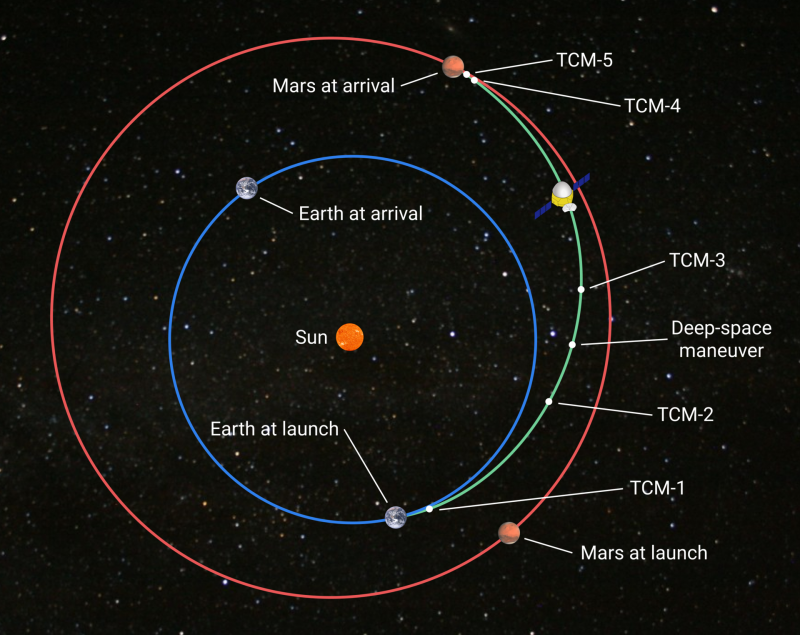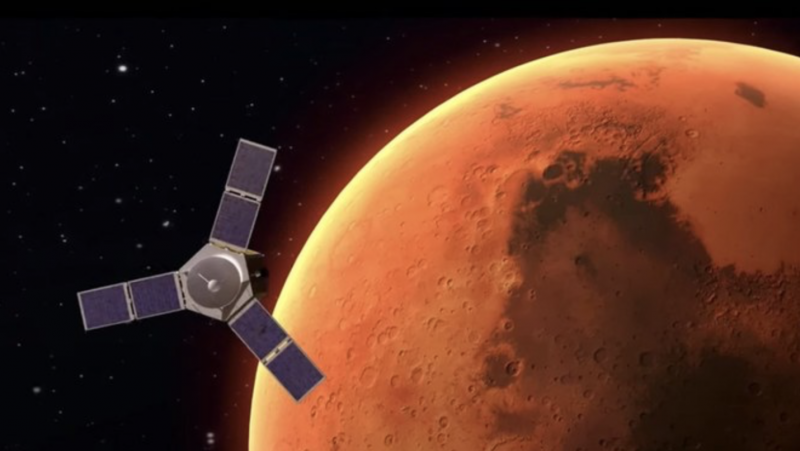
Tianwen-1, China’s Mars mission, entered its orbit around Mars after a 15 minute long burn February 10, 2021 at 12:03:30 UTC (06:03:30 CST). This was a mere one day after the United Arab Emirates Mars mission, called Hope, successfully entered orbit around the red planet, as scheduled, at 15:30 UTC (9:30 CST) on February 9, 2021, followed by widespread celebration in the UAE. Hope and Tianwen-1 thereby made their respective countries the fifth and sixth earthly cultures to successfully reach our red neighboring planet, after the United States, India, the former Soviet Union and Europe (via the European Space Agency).
#BREAKING China's first Mars probe Tianwen-1 has successfully entered the orbit of the red planet after a crucial “brake” to decelerate and be captured by Mars gravity, according to #CNSA. pic.twitter.com/jx2TaN9Z8l
— CGTN (@CGTNOfficial) February 10, 2021
Meanwhile NASA’s Perseverance is set to arrive and land on February 18, 2021. Both the Chinese and the American missions are robotic – consisting of an orbiter, a lander and a rover – and aim to land on the surface of Mars, while the Hope mission will collect its data from orbit.
July 2020 provided a launch window to the planet Mars, and all three missions launched at that time. That’s why all three missions are arriving at Mars this month, on one another’s heels.
Read more about Perseverance here
The 2021 lunar calendars are here! Order yours before they’re gone!
Tianwen-1 is China’s first Mars exploration mission. It is named after an ancient Chinese poem meaning Heavenly Questions. After traveling 292 million miles (470 million km) from Earth, the mission has entered a polar orbit around Mars on February 10, 2020.
Tianwen-1 aims to map Mars’ geology and morphology in order to produce surface maps, to look at the composition of the Martian soil and to explore the distribution of Martian water ice. Like Hope, Tianwen-1 will also look at Mars’ atmosphere, in particular the planet’s ionosphere. You can find a long list of Tianwen-1’s mission goals in this article at Nature Astronomy.

Not until after three months in orbit is Tianwen-1’s lander scheduled to separate from the orbiter in May 2021. The lander, which carries an as yet unnamed rover, will touch ground on Utopia Planitia on Mars, where one of the earliest Mars explorer missions, Viking 2, touched down in 1976. After touchdown – assuming the landing has been accomplished successfully (and remember, landing on Mars is hard) – the lander will unfold a ramp to let the rover out, which will then roll down to Mars’ surface and begin the next part of the mission. If successful, China will be the second country to deploy a rover on Mars and the third country, after the U.S. and the Soviet Union, to make a soft landing in its surface.
As with many Mars missions, including NASA’s Perseverance, Tianwen-1’s overarching goal is to find evidence for past and current life.
Success!
Contact with #HopeProbe has been established again.
The Mars Orbit Insertion is now complete.#ArabsToMars
— Hope Mars Mission (@HopeMarsMission) February 9, 2021
A light display on the supertall Burj Khalifa tower in Dubai celebrates the arrival of the UAE’s Hope spacecraft at Mars. https://t.co/RL7kFP4XcH pic.twitter.com/2AzSZKCg07
— Spaceflight Now (@SpaceflightNow) February 9, 2021
Hope is the first United Arab Emirates interplanetary mission.
Historically, 50% of the Mars missions have failed. Thus these two orbit entering maneuvers of Hope and Tianwen-1 were risky. The February 9 orbit entry for Hope required its six engines to slow the probe from 75,000 mph to 11,000 mph (121,000 kph to 18,000 kph). The maneuver was all preprogrammed, and the mission engineers only knew that it succeeded after the fact.


The science goals of the Emirates Hope mission include studies of the global Martian atmosphere and its upper and lower layers from orbit during two years (one Martian year or 687 days). It will collect data on the lower atmosphere in order to measure climate variations and how weather varies over regions and investigate how the global weather in the lower levels may affect the upper atmosphere.
In particular, the mission will look at how atmospheric gases escape Mars into space over a Martian year, and how that is correlated with the climate variations in the lower atmosphere.
Read more about the UAE’s Hope mission to Mars here

These three Mars missions – from the UAE, China and the U.S. – were all launched in a launch window in July 2020, when it would take the least energy to send something off to Mars. That is, Earth and Mars were in the most favorable positions relative to each other for interplanetary travel. A launch window to Mars opens approximately every two years and two months (780 days, to be exact). Mars takes about two years to orbit the sun once (in contrast to one year for Earth) and so Mars is also generally brightest as seen from Earth about every two years, when Earth is passing between the sun and Mars, bringing Mars to opposition in our sky. But the opening of the launch window doesn’t coincide precisely with Mars’ opposition. 2020’s opposition of Mars came on October 13, 2020. The launch window was a few months earlier, in July.
Hope left Earth from Japan on July 19, 2020, Tianwen-1 from China on July 23, and Perseverance one week later from the U.S. state of Florida on July 30.
Bottom line: The first 2 out of 3 missions to Mars that were all launched in July 2020 have now arrived at Mars and are currently in orbit: the UAE Space Agency’s Hope mission arrived in Mars orbit on February 9, 2021, and the Chinese Tianwen-1 mission entered orbit the day after, on February 10. NASA’s Perseverance is planned to arrive and land on February 18.











